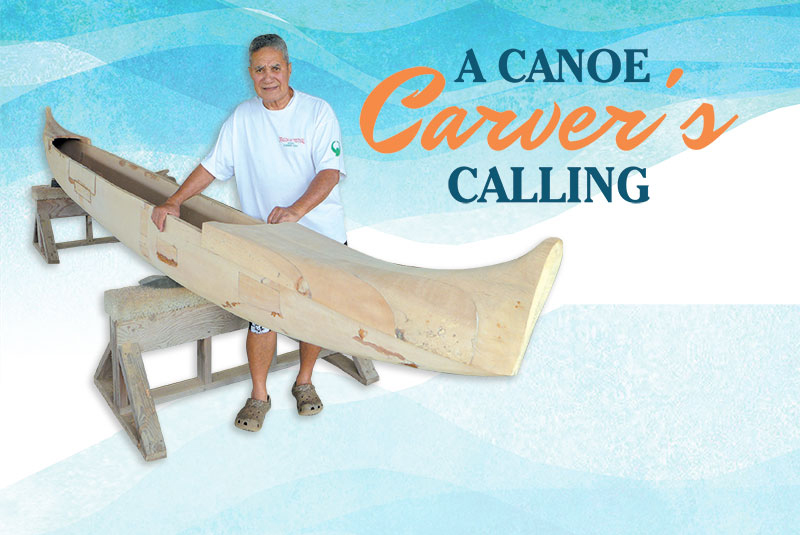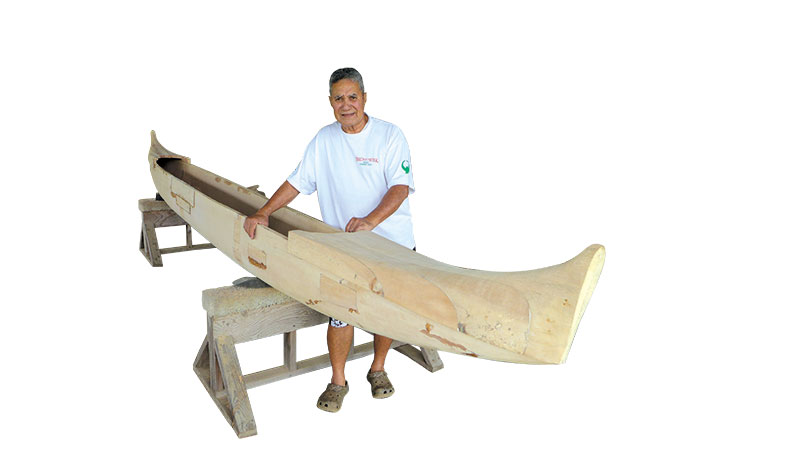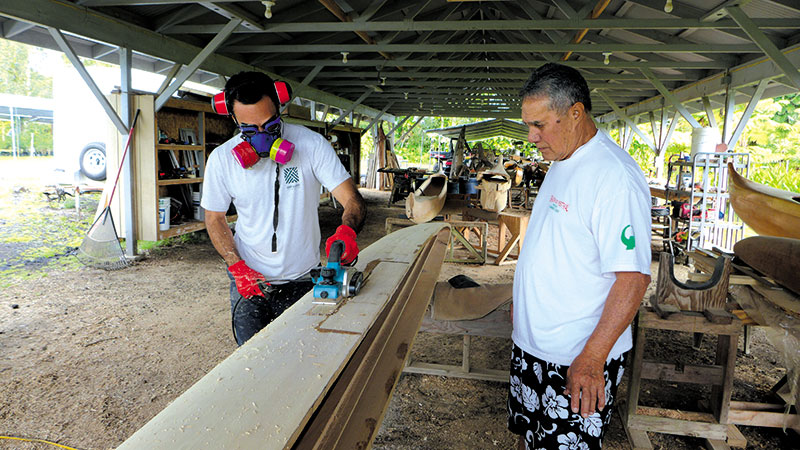A Canoe Carver’s Calling
STORY AND PHOTOS BY KATIE YOUNG YAMANAKA
At 79, Ray Bumatay continues to work with a handful of apprentices to keep the art of canoe carving alive.
In July of 2017, master canoe carver Ray Bumatay and son Alika received a once-in-a-lifetime call from Smithsonian National Museum of Natural History. Curator Joshua Bell asked if they could come take a look at a canoe gifted by Queen Kapi‘olani to the museum in 1887, when she and Princess Lili‘uokalani traveled to England for Queen Victoria’s Golden Jubilee.
The Smithsonian planned to do a 3D reconstruction scan of the original canoe and wanted Hawaiian canoe carvers involved, so they called on the Bumatays to offer their cultural expertise and knowledge. The canoe remains the oldest intact Hawaiian canoe in existence.
A retired state Department of Education teacher, Bumatay has been carving canoes for more than 45 years. He’s also been teaching the art form to just a chosen few, including his two sons, Alika and Doug.
Zak Shimose is one of Bumatay’s select apprentices. He had been studying under Bumatay, learning at the master carver’s home in Pana‘ewa for a little under a year when the Bumatays got a chance to hold a demonstration at the 2019 Merrie Monarch Festival. They taught 22 novice women to carve a contemporary version of the queen’s canoe from albizia wood.
It was Bell who made the demonstration happen, but Shimose helped from the sidelines and wondered if they might try to carve a similar replica using koa wood instead of albizia.
Bumatay and Shimose moved ahead with plans for a second replica but, as it turned out, carving was the easy part.
“Finding koa and finding funding have been challenging. In ancient times, koa was the material used most frequently for canoes, but also ‘ulu and maybe milo,” Shimose explains.
To help facilitate the acquisition of koa, he started nonprofit Hua o Lāhui.
“One place had quoted me $250,000 for the tree,” he says. “But we ended up getting a generous offer from Koholālele Ranch for a koa tree.”
Because of its size, Shimose decided to use this particular log to replicate another canoe gifted by Queen Kapi‘olani — a smaller vessel sent to England that ended up at Norwich Museum in 1891.
Bumatay and Shimose gained funding for the replica project as well as educational demonstrations from Young Brothers, ‘Olukai, Matson and the County of Hawai‘i. They planned to hold two canoe-carving demonstrations in the first half of this year: FestPac Hawai‘i (Festival of Pacific Arts & Culture) on O‘ahu and the 57th annual Merrie Monarch Festival in Hilo, both of which have been canceled or postponed. However, Shimose says they still have plans to move ahead with more demonstrations in the future.
“We want to help share the story of the queen’s canoes,” he says. “I don’t know of any Hawaiian canoe carvers still practicing the art of canoe carving like Uncle Ray is. I don’t think many people know that he is one of the few, if not the last, of the master canoe carvers. Carving is different from building a canoe by planks.
“Carving a canoe, as Uncle Ray puts it, keeps the mana of the tree in the canoe. It is a traditional Hawaiian practice that is rarely carried out in today’s world where the value and rarity of koa makes it more prudent and environmentally friendly to build plank canoes.”
Shimose maintains that the replica project is worthy of using a koa log.
“The replica ties in the history of Hawai‘i to today’s world,” he explains. “This canoe was a part of the Hawaiian kingdom. When one thinks about the kings and queens of Hawai‘i, it seems ancient, but this shows otherwise. And in carving this replica, it perpetuates this dying cultural practice of canoe carving and also showcases the knowledge of Uncle Ray.”
Bumatay carves by chain-saw.
“What people might not know about carving a canoe is it’s mostly about the tools we use,” says the elder Bumatay, 79. “There are a lot of accessories that can be attached to the chainsaw that will make the work go faster. Way back, the old folks used stone tools and coral to carve a canoe. What I do in two days would take most people six months using other tools.”
Bumatay keeps a watchful eye on every step of the carving process: leveling the top, drawing the outline, cutting the shape of the bottom and the corners of the vessel, and hollowing out the canoe.
“The canoe I saw (at the Smithsonian) is a thing of beauty,” says Bumatay. “Her lines just flowed together. I was told it was a fishing canoe, but I strongly disagree. That canoe was created for recreational use. It was slim and shallow. It was not designed to carry a load of fish. In doing this replica, I’m hoping to duplicate the beauty of that canoe by copying its original lines. I’m interested in bringing out the grace and beauty of the canoe.”
He says that he hopes the project will generate more interest in canoe carving.
“What I would like to see is more people keeping this art alive,” says Bumatay.
Shimose says he feels the project is for the people of Hawai‘i.
“The finished product will be gifted to a local organization that is helping the people in Hawai‘i,” he says. “This project is truly a community effort that helps to perpetuate the traditions and culture of Native Hawaiians. From the health of the forest to the health of the ocean, it involves the entire ahupua‘a.”
Through Hua o Lāhui, Shimose is looking into doing a virtual canoe-carving demonstration, as well as a live demo at a later date on O‘ahu. He is also working on a documentary of the carving process with Hawaiian subtitles, as well as a Hawaiian version with English subtitles — a project with Ka ‘Umeke Kā‘eo School — and a traveling exhibit of the canoe currently housed in England, bringing it back to Hawai‘i in the spring of 2021.






